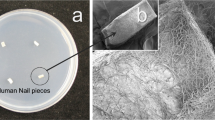Abstract
The aim of this study was to evaluate, for the first time, the antifungal efficacy of nanocapsules and nanoemulsions containing Melaleuca alternifolia essential oil (tea tree oil) in an onychomycosis model. The antifungal activity of nanostructured formulations was evaluated against Trichophyton rubrum in two different in vitro models of dermatophyte nail infection. First, nail powder was infected with T. rubrum in a 96-well plate and then treated with the formulations. After 7 and 14 days, cell viability was verified. The plate counts for the samples were 2.37, 1.45 and 1.0 log CFU mL−1 (emulsion, nanoemulsion containing tea tree oil and nanocapsules containing tea tree oil, respectively). A second model employed nails fragments which were infected with the microorganism and treated with the formulations. The diameter of fungal colony was measured. The areas obtained were 2.88 ± 2.08 mm2, 14.59 ± 2.01 mm2, 40.98 ± 2.76 mm2 and 38.72 ± 1.22 mm2 for the nanocapsules containing tea tree oil, nanoemulsion containing tea tree oil, emulsion and untreated nail, respectively. Nail infection models demonstrated the ability of the formulations to reduce T. rubrum growth, with the inclusion of oil in nanocapsules being most efficient.




Similar content being viewed by others
References
Bakkali F, Averbeck S, Averbeck D, Idaormar M. Biological effects of essential oils—A review. Food Chem Toxicol. 2008;46:446–75.
Hart PH, Brand C, Carson CF, Riley TV, Prager RH, Finlay-Jones JJ. Terpinen-4-ol, the main component of the essential oil of Melaleuca alternifolia (tea tree oil), suppresses inflammatory mediator production by activated human monocytes. Inflamm Res. 2000;49:619–26.
Carson CF, Hammer KA, Riley TV. Melaleuca alternifolia (tea tree) oil: a review of antimicrobial and other medicinal properties. Clin Microbiol Rev. 2006;19(Suppl. 1):50–62.
Hammer KA, Carson CF, Riley TV, Nielsen JB. A review of the toxicity of Melaleuca alternifolia (tea tree) oil. Food Chem Toxicol. 2006;44:616–25.
Guterres SS, Alves MP, Pohlmann AR. Polymeric nanoparticles, nanospheres and nanocapsules, for cutaneous applications. Drug Target Insights. 2007;2:147–57.
Mishra B, Patel BB, Tiwari S. Colloidal nanocarriers: a review on formulation technology, types and applications toward targeted drug delivery. Nanomedicine. 2010;6:9–24.
Noskin GA, Rubin RR, Schentag JJ, Kluytmans J, Hedblom EC, Smulders M, Lapentina E, Gemmen E. The burden of Staphylococcus aureus infections on hospitals in the United States. Arch Intern Med. 2005;165(Suppl. 15):1756–61.
Sidrim JJC, Rocha MFG. Micologia médica à luz de autores contemporâneos. Guanabara Koogan S.A., Copyright, Rio de Janeiro, RJ; 2004.
Degreef H. Clinical forms of dermatophytosis (Ringworm infection). Mycopathologia. 2008;166:257–65.
Nakashima T, Nozawa A, Ito T, Majima T. Experimental tinea unguium model to assess topical antifungal agents using the infected human nail with dermatophyte in vitro. J. Infect Chemother. 2002;8:331–5.
Marty JPL. Amorolfine nail lacquer: a novel formulation. J Eur Acad Dermatol Venereol. 1995;4(Suppl. 1):17–21.
Baran R, Tosti A, Hartmane I, Altmeyer P, Hercogova J, Koudelkova V, Rozicka T, Combemale P, Mikazans I. An innovative water-soluble biopolymer improves efficacy of ciclopirox nail lacquer in the management of onychomycosis. J Eur Acad Dermatol Venereol. 2009;23:773–81.
Murdan S. Drug delivery to the nail following topical application. Int J Pharm. 2002;236:1–26.
Kobayashi Y, Komatsu T, Sumi M, Numajiri S, Miyamoto M, Kobayashi K, Morimoto Y. In vitro permeation of several drugs through the human nail plate: relationship between physicochemical properties and nail permeability of drugs. Eur J Pharm Sci. 2004;21:471–7.
Flores FC, Ribeiro RF, Ourique AF, Pohlmann AR, Beck RCR, Guterres SS, Rolim CMB, Silva CB. Nanostructured systems containing an essential oil: protection against volatilization. Quim Nova. 2011;34:968–72.
Bouchemal K, Briançon S, Perrier E, Fessi H. Nano-emulsion formulation using spontaneous emulsification: solvent, oil and surfactant optimization. Int J Pharm. 2004;280:241–51.
Fessi H, Puisieux F, Devissaguet JPh, Ammoury N, Benita S. Nanocapsule formation by interfacial polymer deposition following solvent displacement. Int J Pharm. 1989;55(Suppl. 1):R1–4.
Schaller M, Borelli C, Berger U, Walker B, Schimdt S, Weind G, Jäckels A. Susceptibility testing of apomorphine, bifonazole and ciclopiroxolamine against Trichophyton rubrum in an in vitro model of dermatophyte nail infection. Med Mycol. 2009;47:753–8.
Yang D, Michel L, Chaumont JP, Millet-Clerc J. Use of caryophyllene oxide as an antifungal agent in an in vitro experimental model of onychomycosis. Mycopathologia. 1999;148:79–82.
Paulo CSO, Vidal M, Ferreira LS. Antifungal nanoparticles and surfaces. Biomacromolecules. 2010;11:2810–7.
Muralimohan A, Eun Y-J, Bhattacharyya B, Weibel DB. Dissecting microbiological systems using materials science. Trends Microbiol. 2009;17(Suppl. 3):100–8.
Lboutounne H, Chaulet JF, Ploton C, Falson F, Pirota P. Sustained ex vivo skin antiseptic activity of chlorhexidine in poly(e-caprolactone) nanocapsule encapsulated form and as a Digluconate. J. Control. Release. 2002;82:319–34.
Padmavathy N, Vijayaraghavan R. Enhanced bioactivity of ZnO Nanoparticles- an antimicrobial study. Sci Technol Adv Mater. 2008;9:35004–11.
Nhung DTT, Freydiere AM, Constant H, Falson F, Pirot F. Sustained antibacterial effect of a hand rub gel incorporating chlorhexidine-loaded nanocapsules (Nanochlorex®). Int J Pharm. 2007;334:166–72.
Ranjita S, Loaye AS, Khalil M. Present status of nanoparticle research for treatment of tuberculosis. J. Pharm. Pharm. Sci. 2011;4(Suppl. 1):100–16.
Gunt H, Kasting GB. Effect of hydration on the permeation of ketoconazole through human nail plate in vitro. Eur J Pharm Sci. 2007;32:254–60.
Acknowledgments
The authors thank to CNPq-Brasília/Brazil for financial support.
Author information
Authors and Affiliations
Corresponding author
Rights and permissions
About this article
Cite this article
Flores, F.C., de Lima, J.A., Ribeiro, R.F. et al. Antifungal Activity of Nanocapsule Suspensions Containing Tea Tree Oil on the Growth of Trichophyton rubrum . Mycopathologia 175, 281–286 (2013). https://doi.org/10.1007/s11046-013-9622-7
Received:
Accepted:
Published:
Issue Date:
DOI: https://doi.org/10.1007/s11046-013-9622-7




